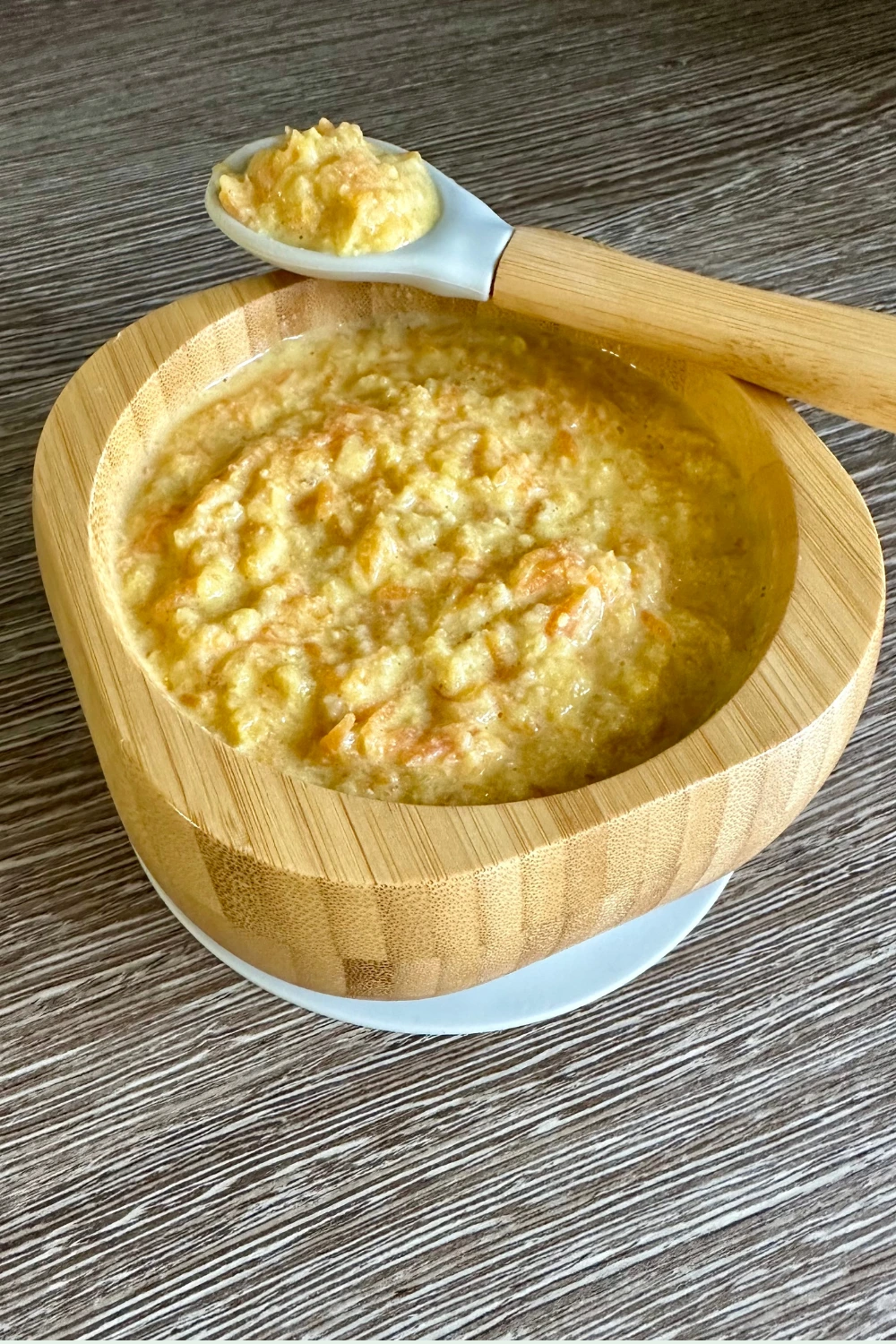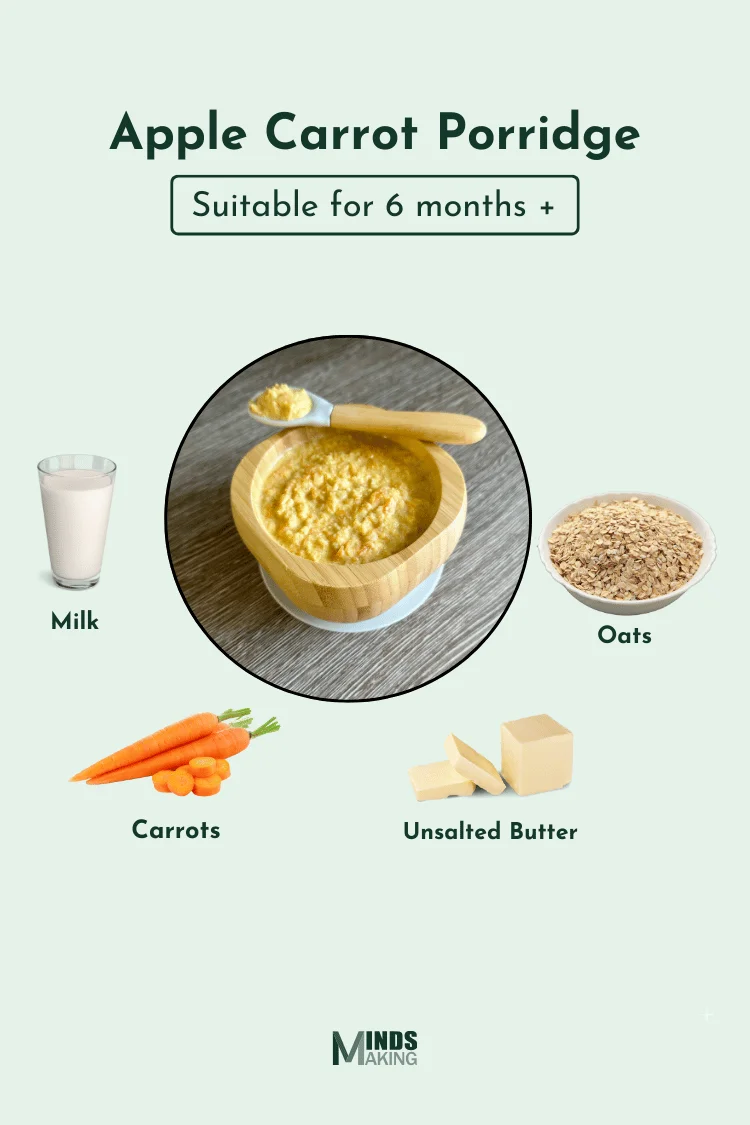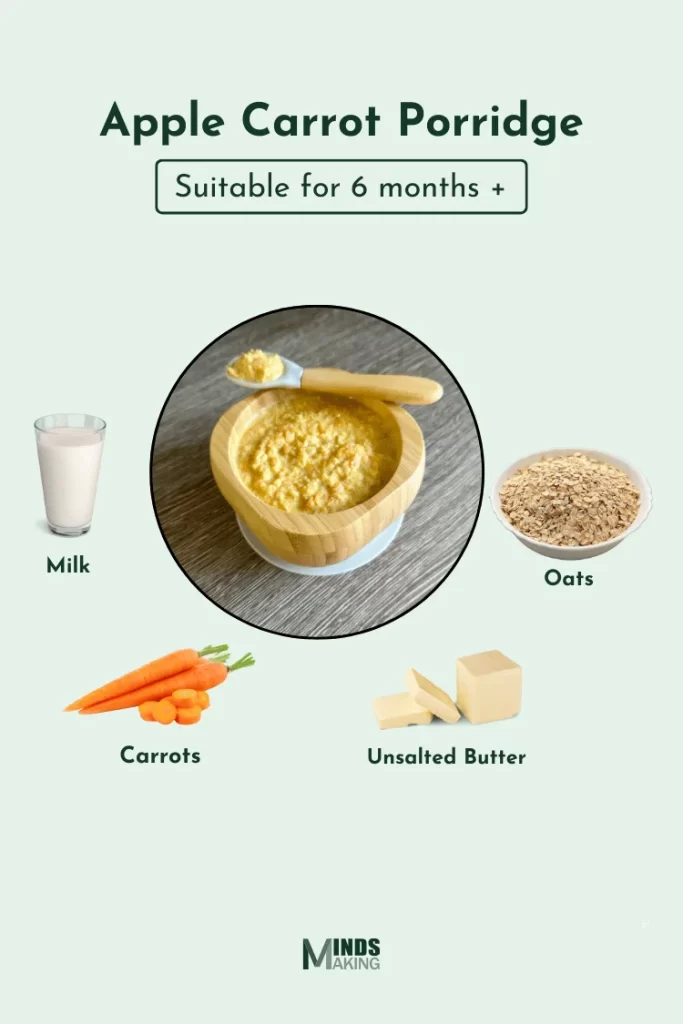Menu


Nutrient-Rich: It combines apples, carrots, and oats, providing vitamins, fibre, and healthy carbs essential for growth and digestion.
Natural Sweetness: The apple and carrot add a gentle sweetness without added sugars, making it tasty yet baby-friendly.
Soft Texture: The ingredients cook down to a smooth, soft texture that’s easy for babies and toddlers to eat and digest.
Customisable Ingredients: You can adjust the milk type and add other nutritious ingredients, making it suitable for various dietary needs.
Encourages Food Exploration: With mild flavours and wholesome ingredients, it introduces babies to a variety of textures and tastes.

Begin by heating a medium-sized pan over medium heat. Once the pan is warm, add the unsalted butter and let it melt completely, ensuring it coats the bottom of the pan evenly.
Add the grated apple and carrot to the pan. Stir-fry them in the melted butter for a few minutes, stirring frequently, until they start to soften and release their natural sweetness. This should take about 3-4 minutes.
Once the apple and carrot have softened, add the oatmeal to the pan. Stir the mixture continuously for another minute or two, allowing the oats to absorb some of the flavours and lightly toast.
Pour in the milk of your choice. If you’re using breast milk or formula, it’s recommended to use water for this step and add the milk later. Bring the mixture to a gentle boil over medium heat.
After reaching a boil, reduce the heat to low and let the mixture simmer. Cook for about 5-7 minutes, or until the oats are fully cooked and the porridge has thickened. Stir occasionally to prevent the mixture from sticking to the pan and to ensure even cooking.
Once the porridge has finished cooking, remove it from the heat and let it cool to a safe temperature before serving it to your baby. If you used water initially, stir in the breast milk or formula after the porridge has cooled slightly.
Fresh apple and carrots will make a difference in taste and nutritional value. Older produce might not have the same sweetness, so using fresh ingredients will add more flavour naturally.
2. Grate Finely for a Smooth Texture
Grate the apple and carrots as finely as possible so that they soften quickly and blend well with the oats. This also helps ensure a uniform texture that’s easy for babies to eat.
3. Cook the Apple and Carrot Thoroughly
Cooking the apple and carrot until they’re soft will release their natural sweetness, reducing the need for any added sweeteners. Stir frequently while cooking to avoid burning and to ensure they cook evenly.
4. Lightly Toast the Oats
Stirring the oats for a minute or two before adding the liquid will bring out a slight nutty flavour and help them better absorb the flavours of the apple, carrot, and butter.
5. Stir Regularly to Avoid Clumping
Regular stirring prevents the oats from clumping together and sticking to the bottom of the pan, which also ensures a smooth, creamy texture.
6. Adjust the Consistency if Needed
Once the porridge is done, you can adjust the texture. If it’s too thick, add a bit more warm milk or water to achieve the right consistency for your baby.
7. Cool to a Safe Temperature
Cool the porridge to lukewarm before serving to your baby. Porridge retains heat well, so giving it a few extra minutes to cool down ensures safety.
8. Blending for Younger Babies
For younger babies who need a very smooth texture, you can blend the porridge in a baby blender or with an immersion blender after cooking to eliminate any lumps.
Pears or Banana: Substitute the apple with a peeled and grated pear for a similar mild sweetness, or mashed banana for a creamier texture and a slightly different flavour.
Carrots
Pumpkin or Sweet Potato: Grated pumpkin or finely grated sweet potato are great alternatives. Both add a similar natural sweetness and a smooth texture when cooked.
Milk
Plant-Based Milk: Use unsweetened oat milk, almond milk, or coconut milk for a dairy-free option. These can add a unique flavour —coconut milk, for instance, brings a subtle tropical sweetness.
Oatmeal
Millet or Rice Cereal: For babies who may have a sensitivity to oats, you can substitute with millet flakes or rice cereal, both of which cook down to a smooth, porridge-like texture.
Quinoa Flakes: Another nutrient-dense option, quinoa flakes cook quickly and add a mild nutty flavour.
Butter
Coconut Oil or Olive Oil: Coconut oil can add a touch of extra sweetness and creaminess, while olive oil is a good alternative for its mild flavour and health benefits. Both can work well for dairy-free diets.
Berries or Peaches: Add mashed or pureed blueberries, strawberries, or peaches after cooking for added flavour and colour. These fruits add antioxidants and variety to the taste.
Almond Butter or Peanut Butter: If your baby has been introduced to nuts, adding a small spoonful of almond or peanut butter can provide healthy fats, protein, and a creamier texture.
Greek Yoghurt: After cooking, you can add a spoonful of plain greek yoghurt for extra protein and creaminess.
Chia or Flax Seeds: For babies who tolerate seeds, a tiny sprinkle of ground chia or flax seeds adds fibre, protein, and healthy fats.
Apple or Banana Slices: Place a few thin apple or banana slices on top of the cooled porridge. You can also mash or lightly cook these to make them easier for your baby to chew.
Berry Purée Swirl: For extra flavour and a touch of colour, swirl in a bit of blueberry, strawberry, or raspberry purée on top after cooking.
Yoghurt: A spoonful of plain greek yoghurt or unsweetened coconut yoghurt on top adds creaminess and a bit of tang, which complements the porridge’s sweetness.
Mashed Avocado: For a more savoury touch, add a small dollop of mashed avocado for a creamy texture and healthy fats.
Chia or Ground Flax Seeds: A tiny sprinkle of chia or ground flax seeds can add nutrition and a slight crunch.
Shredded Coconut: For babies with no allergies, a sprinkle of finely shredded coconut adds a tropical twist.
Fruit and Porridge Layers: Create mini layers in a small cup or bowl, alternating between porridge and pureed or diced soft fruits, like apples, pears, or berries. This adds visual appeal and varying textures.
Baby-Friendly “Granola”: Add a few pieces of soft-cooked oatmeal clusters or crumbled baby biscuit on top to mimic a parfait’s texture.
With Soft Fruit Sticks for Dipping: For older babies, you can cut soft fruits (like banana sticks or steamed apple slices) to dip into the porridge, giving them a chance to practice self-feeding.
Toast Fingers or Oat Biscuits: Serve alongside soft, baby-safe toast fingers or unsweetened oat biscuits for scooping up the porridge, turning it into a more interactive meal.
Use a divided baby plate, with the porridge in one section and small servings of colourful, soft fruits or steamed veggies in the others. This lets your baby explore different tastes and textures.
Blend with Milk for a Smooth Texture: For younger babies who prefer smoother textures, blend the cooked porridge with a little extra milk or water until it’s very creamy. Serve in a small, shallow bowl to make spoon-feeding easier.
Warm for Cosy Comfort: Serve the porridge warm in cooler weather as a comforting meal.
Cold for a Refreshing Treat: In warmer weather, the porridge can be served chilled as a refreshing snack or breakfast, with added fruits on top.
Refrigerating the Porridge:
Remember to always check the temperature of the reheated porridge before feeding it to your baby to ensure it’s not too hot.

Begin by heating a medium-sized pan over medium heat. Once the pan is warm, add the unsalted butter and let it melt completely, ensuring it coats the bottom of the pan evenly.
Add the grated apple and carrot to the pan. Stir-fry them in the melted butter for a few minutes, stirring frequently, until they start to soften and release their natural sweetness. This should take about 3-4 minutes.
Once the apple and carrot have softened, add the oatmeal to the pan. Stir the mixture continuously for another minute or two, allowing the oats to absorb some of the flavours and lightly toast.
Pour in the milk of your choice. If you’re using breast milk or formula, it’s recommended to use water for this step and add the milk later. Bring the mixture to a gentle boil over medium heat.
After reaching a boil, reduce the heat to low and let the mixture simmer. Cook for about 5-7 minutes, or until the oats are fully cooked and the porridge has thickened. Stir occasionally to prevent the mixture from sticking to the pan and to ensure even cooking.
Once the porridge has finished cooking, remove it from the heat and let it cool to a safe temperature before serving it to your baby. If you used water initially, stir in the breast milk or formula after the porridge has cooled slightly.
Suitable from 6 months
Nutrition per serving (approximate):
© Mindsmaking 2024